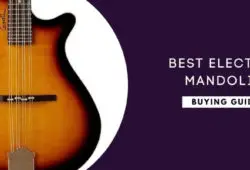Bluegrass mandolins are the most common types of modern mandolins, and with so many options to choose from, it can be challenging to tell a good mandolin apart from an inferior quality one.
When playing bluegrass, you essentially need a mandolin that can fill the rhythmic chordal role while sufficiently holding its own during fills and breaks. Sounds simple enough, right?
Well, let’s see how you can identify the best mandolin for bluegrass, shall we?
Table of Contents
Best Mandolins For Bluegrass Music
1. Stagg M50E Review: Best Mandolin For Beginners
The Stagg M50E is an excellent bluegrass mandolin that can be played acoustically or electrically when plugged into an amplifier.
This mandolin features two f-holes and a single-coil pickup with adjustable volume and tone controls.
The build quality is excellent, and the open gear machine heads stay in tune pretty well.
- It holds tune reasonably well.
- Sounds excellent when playing unplugged.
- Great playability.
- The pickguard fits poorly.
2. The Loar LM-110-BRB Review: Best Value For Money
The minute you strum the mandolin strings, you can clearly hear the authentic mandolin chop, which speaks of the instrument’s quality.
It comes with a hand-carved solid spruce top which is a feature you would only find on the best quality mandolins, while lower quality mandolins have tops made from laminated wood.
In addition to providing authentic chops, this soundboard also guarantees enough vibration to ensure the mandolin can cut through in an ensemble setting.
The maple neck has a thin “V” profile that sits comfortably in the player’s hands, and the shorter scale makes it easier to play.
This acoustic mandolin is an A-style model, which you don’t often find being used in bluegrass music.
However, the advantage is that A-style body mandolins are cheaper than their florentine counterparts, so you get a quality instrument at a fraction of the price.
- Excellent value for money.
- Comfortable and easy to play.
- Has an authentic bluegrass sound.
- Does not come with a case.
3. Ibanez M522SBS Review: Best Sound Projection
This mandolin has some impressive features, including a solid Sitka spruce top and a flamed maple back which contribute to the fantastic projection you get.
The maple neck has a longer scale length of 13.8”, which means the bluegrass musician can hit high notes for that classic bluegrass sound.
At the same time, the rosewood fingerboard with 24 frets and a flat radius is pretty comfortable to hold and play even during prolonged playing sessions.
For aesthetics, the gold die-cast tuners with Pearloid knobs are a nice touch, as are also acrylic block inlays and the ivory body binding.
- Pretty loud and projects very nicely.
- Aesthetically appealing.
- Very well built.
- It may have some cosmetic imperfections.
4. The Loar LM-520-VS Performer Mandolin Review
If you are looking for a high-value mandolin that sounds great and has low key appointments, look no further.
This hand-carved instrument comes with a spruce top, maple back, and solid maple sides, which all contribute to the bright clear tone you get from the mandolin.
Another nice premium feature is the high-quality vintage-style Grover tuning machines used to ensure that the mandolin has excellent intonation and will stay in tune longer.
The single layer of ivory binding gives this instrument a streamlined look, and the minimal appointments meant that it would be the perfect mandolin for players who don’t need all the bells and whistles.
- Excellent build quality.
- Great comfort and playability.
- High-end tone with a loud percussive chop.
- Requires professional setup before playing.
What Makes A Bluegrass Mandolin Different From A Normal Mandolin?
Chops
One of the key things that set the bluegrass mandolin apart is its ability to chop a chord authoritatively, a technique also known as chunking. Essentially, chops are chords that do not leave any open mandolin strings.
You perform a chop by playing sharp chords on the “upbeats” or “offbeats”, which refer to each bar’s second and fourth beats. Shortly after striking each chord, you release the pressure of the fingers, thereby using the chop to create a driving, percussive effect.
This slightly percussive attack allows these mandolins to carry well in a band context, cutting through everything else. A strong offbeat chop is pivotal to bluegrass music, and it is also what brings out the bass and guitar rhythm.
Volume & Projection
Mandolins for bluegrass music should be able to cut through the pretty well so that they can hold their own during breaks and fills.
“Breaks” are showy instrumental improvisations that intersperse the verses and chorus in bluegrass music. The melody instruments provide breaks, and these acoustic instruments are designed to have a loud enough volume to be heard when playing in a jam alongside the banjo, guitar, fiddle, and upright bass.
In addition to having a more projecting sound, mandolins for bluegrass also have more bass than treble. These instruments always come strung with steel mandolin strings.
High-Quality Melody
The instrument should give you a nice solid notation when playing lead breaks without a long sustaining ring after the note is struck.
Additionally, bluegrass music demands a more piercing sound that’s more directionally focused, thereby giving you a tone that’s richer and more complex.
On the other hand, folk mandolins have a big, open sound that isn’t very refined and can even sound brash at times. This would not be ideal for bluegrass music.
What To Consider When Buying A Mandolin For Bluegrass
F-Style Mandolin
There are two broad mandolin styles: the plain-looking teardrop-shaped A-style mandolin and the more stylized Florentine F-style. Typically, the best mandolin for playing bluegrass is the F-style which comes with a scroll on the upper side and a couple of points on the lower side of the instrument.
These extra curlicues increase the volume of the instrument’s body just so slightly. Increased volume means that there would be a lowered frequency of air resonance, in turn resulting in more bass, which suits bluegrass music.
F-Shaped Sound Holes
Having an F-shaped sound hole helps significantly with both these properties, making these the best mandolins for bluegrass musicians.
Typically, all F-style instruments come with F-shaped sound holes. That being said, it still is possible to find some A Style mandolins having the 2 F-holes similar to a violin’s. Whichever the case, F-shaped holes are better for bluegrass music for various reasons.
1. F-holes give that nice bluegrass pop that you just wouldn’t get from round or oval-shaped soundholes. This is especially the case when you play the acoustic rather than the electric mandolin.
2. F-holes result in a much crisper toner, whereas round sound holes have less crispiness.
3. F-holes produce a compressed sound which works better for chops, allowing the instrument to hold its own against other instruments when playing bluegrass on large stages.
4. F-holes allow for a sharper attack and quicker sound decay, which works well for chops.
5. F-holes have better volume and sound projection, so the instrument can cut through and project well, especially when playing lead on mandolin breaks. An oval soundhole’s sweet, mellow tone can get lost in bluegrass music.
6. F-holes allow for a bright clear tone, in contrast to the warm, sustained tone that you would get from a round or oval soundhole.
Arched Top
An arched top or carved-top mandolin imitates the construction of a violin whereby the soundboard is slightly carved or arched, as opposed to lying flat. This carved, convex top hardly requires any internal structure such as bracing and struts and is believed to increase the instrument’s resonant and vibratory qualities.
While flat tops are more resonant, with an open sound that has more sustain, arched tops are more piercing with better sound projection and less sustain.
Instead of filling the air like a flat top, the sound from an arched top mandolin is much more directionally focused, making it more complex.
Flat Back
The best mandolin for playing bluegrass should have a flat or nearly flat back. The vintage mandolin had a rounded bowl-shaped back which was difficult to play in a standing position, making it unsuitable for bluegrass.
A decent mandolin should have a flat or nearly flat back which is more comfortable to hold and play.
Setup
Just like you need quality guitar strings for an acoustic guitar, you similarly need high-quality mandolin strings on a bluegrass mandolin. These mandolin strings should be made of steel and strung tight to allow the player to hit high notes.
Also, for bluegrass, a longer scale length is preferred to a shorter one because the longer scale with more frets gives the player access to higher notes.
Conclusion
Some people argue that how you play the instrument, rather than the model of the mandolin, is what makes it bluegrass. There may be some truth in that. However, while you can get a good mandolin that would be adequate for bluegrass, the point is that it just wouldn’t be optimum.
The best mandolin for playing bluegrass should be optimised for just that, giving you peak performance with relatively little effort regardless of your competence in playing the music.
At the same time, it is essential to remember that although they are labeled as bluegrass mandolins, these instruments can play pretty much anything from modern rock to bluegrass and country music.









